The Historic Link Between The US Space Program, Special Operations Forces, & Timepieces
In 2020, some 45 years had passed since a crewed US spacecraft splashed down at sea. On 2 August, NASA astronauts Douglas Hurley and Robert Behnken experienced no less than four g’s as they hurtled toward the Earth in Elon Musk’s SpaceX Crew Dragon Endeavour. The mission, Crew Demo-2, marked historic firsts including the first crewed commercial space flight as well as the first two-person orbital space flight launched from the United States since STS-4 in 1982. Slowed by four massive parachutes, Demo-2’s Endeavour capsule splashed down in the Gulf of Mexico, just off the coast of Pensacola, Florida, at 2:48 pm. But what then?

SpaceX’s Crew Demo-2, the first crewed private space flight, is towed to a support vessel after recovery at sea in 2020. (Photo Credit: NASA)
The model of launch, flight, reentry, splashdown in the ocean, and recovery, was established during the earliest days of manned space flight. Considerably safer than returning to earth on land, NASA has traditionally favored a waterborne splashdown for its manned space flights, including the storied Mercury, Gemini, and Apollo missions as well as more recent efforts including Artemis. However, things can and have gone wrong. Assuming the capsule meets the sea as intended, it can still sink or capsize, presenting a perilous situation for any astronauts inside.
One area of space travel that goes mostly unexplored by enthusiast media is the long-standing relationship between select SpecOps units and the Space Program. Starting with US Navy Underwater Demolition Teams and Air Force Pararescue Teams in the 1960s and carrying on through modern SpaceX, Boeing, and Artemis missions, the challenging tasks of astronaut recovery and/or rescue continue to be quietly carried out with the help of specialized units from the US Department of Defense. Given the timing, early astronaut recovery teams wore some of history’s most iconic tool watches with names like the Submariner and Sea Wolf on the dial. Today, a select few still choose to wear mechanical watches for the challenging task of plucking spacemen from the ocean.

Former US Air Force Pararescuemen (PJ) RJ Casey trains with NASA astronaut Doug Hurley, USMC, and the SpaceX Astronaut Rescue and Recovery Team. (Photo Credit: NASA Astronaut Anil Menon)
To understand how SOF supports astronaut recovery today, we spoke with RJ Casey, who contracts as an astronaut rescue and recovery team leader at SpaceX. RJ’s history, which is deserving of a separate Dispatch, starts in Special Forces (SF) where he served as an SF Medical Sergeant and Detachment Officer (18D and 18A, respectively) assigned to 2/19th SFG in the West Virginia Army National Guard. A qualified Combat Diver, RJ picked up a Rolex Submariner in the early 2000s that he still wears today. A legendary watch in special operations, the Submariner serves as a nod to Special Forces units of the past, other more shadowy government agencies, and especially their maritime communities.
RJ later joined the US Air Force’s Pararescue community where he currently serves as a reserve Combat Rescue Officer when he isn’t training and recovering astronauts at his civilian job. Today, RJ primarily wears his Bremont S502 Jet, a watch from the brand’s Military and Special Projects Division that he has used for all of his astronaut operations and training evolutions to date.
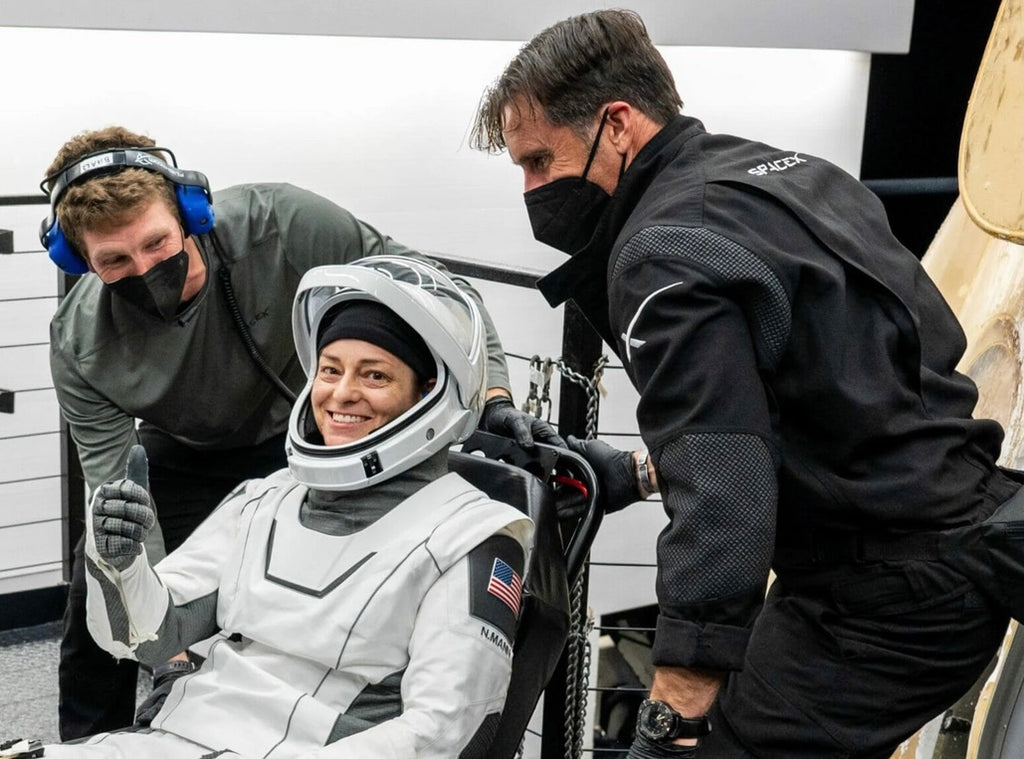
RJ Casey assists NASA Astronaut Nicole Mann, USMC, and Crew-5 Commander, out of SpaceX’s Dragon capsule, pictured with his Bremont S502 Jet military project watch. (Photo Credit: NASA)
While space flight has come a long way, having elite rescue specialists like RJ nearby is still a requirement for manned space missions today. SpaceX and NASA’s modern capsule recovery efforts have gone largely without incident, but the involvement of units from the US Navy and Air Force as an additional layer of contingency for these missions is, like so many other lessons in space exploration, the result of a near miss that almost cost the United States the life of an astronaut.
How A Near Miss Galvanized A Historic Relationship
In 1961, Mercury-Redstone 4 was NASA’s second manned space flight, lasting only fifteen minutes and thirty-seven seconds. Astronaut Gus Grissom, a legendary member of the original Mercury Seven, would have been forgiven for thinking the hard work was behind him. After a successful trip into sub-orbit, the second American in space descended towards the Earth. Liberty Bell 7’s parachutes deployed as intended, and the capsule splashed down approximately 300 miles from its launch location in Cape Canaveral, Florida. Job done. Or so it seemed.

Astronaut Gus Grissom, the second American in space. (Photo Credit: National Air And Space Museum)
As Marine helicopters from the awaiting USS Randolph approached, Liberty Bell 7’s explosive hatch blew off of the capsule, almost immediately filling the spacecraft with water. A veteran of 100 combat missions in Korea, Grissom acted quickly, leaping from the open hatch to escape the sinking capsule but forgetting to close a valve on his space suit. Mistakenly thinking the astronaut was relatively safe, the crew of the primary recovery helicopter turned its attention to the rapidly sinking spacecraft.
Grissom, whose suit was quickly flooded, waved and shouted as he struggled to keep his head above water. At the time, NASA procedures did not call for someone in a boat or in the water to assist with the astronaut’s egress from the capsule. Unfortunate for NASA, but lucky for Grissom, Liberty Bell 7 could not be saved. As the primary recovery helicopter battled with the weight of the sunken capsule, ultimately electing to cut it loose to the depths, the secondary helicopter swooped in to recover one very tired astronaut. One mechanical misstep and NASA very nearly lost its second man in space.
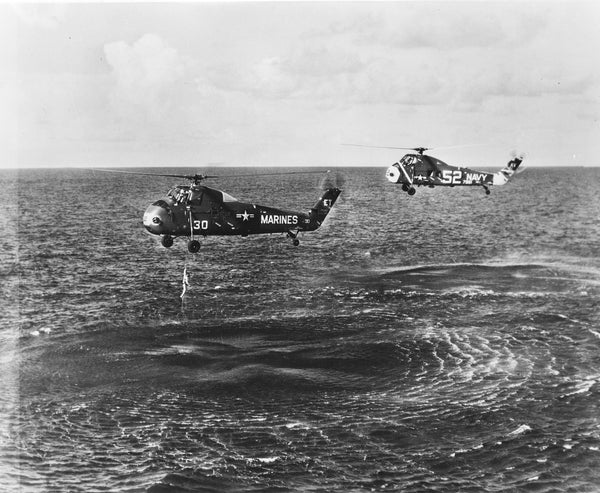
After his harrowing ordeal, Grissom is lifted to safety by a Marine helicopter. (Photo Credit: National Air And Space Museum)
NASA & The Frogmen Of The Underwater Demolition Teams
While NASA already had ties to DOD for assistance in astronaut recovery or rescue, Grissom’s near miss illustrated the necessity of having trained personnel in the water at the splashdown location in the event of a similar mishap. Lacking such personnel, NASA looked to the US Navy’s Underwater Demolition Teams, composed of “frogmen” with extensive experience in challenging open ocean conditions. Tracing their origins to nascent maritime special operations units established during World War II, the UDTs received specialized training in diving, ordnance disposal, beach clearance, and hydrographic reconnaissance, serving as the predecessor to the SEAL Teams which were established in 1962.
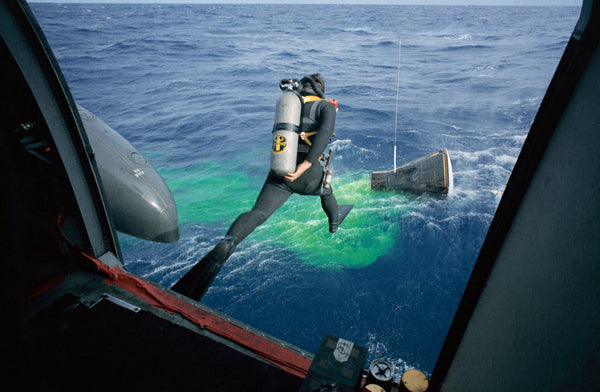
A Navy frogman leaps from a recovery helicopter into the water to assist in the Gemini-12 recovery operations in 1966. (Photo Credit: NASA)
From Mercury 6 onwards, recovery teams composed of specially selected members of various UDTs around the country were required on location to assist with astronaut and capsule recovery operations from the water. Along with a wide variety of specialized equipment more directly related to the mission, the frogmen used the iconic tool dive watches of the day including the Rolex and Tudor Submariner, Zodiac Sea Wolf, and others. Rather than timing dives, the operators utilized these now legendary watches to remain synchronized with the broader multi-agency recovery operation.
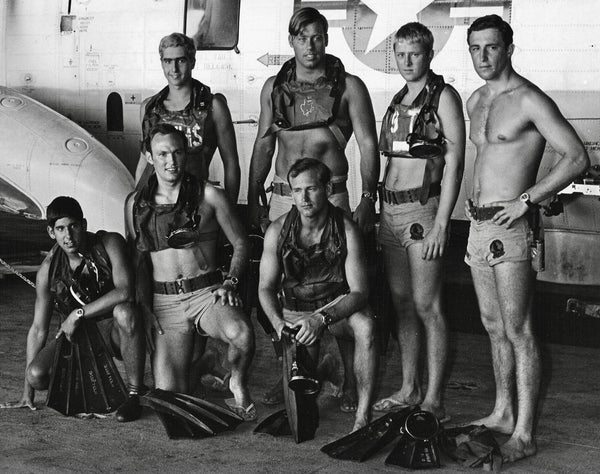
Members of UDT 13 served as the recovery team for Apollo 12. The Tudor Submariner and Zodiac Sea Wolf can be seen on some of the frogmen. (Photo Credit: Navy Helicopter Association Historical Society)
In the majority of the Mercury, Gemini, and Apollo flights, the mission of the UDT recovery teams was relatively straightforward and carefully outlined in this incredible NASA training film from the Mercury Program. After jumping into the sea from a recovery helicopter, the UDT men were tasked with making contact with the capsule before unfolding and deploying an inflatable auxiliary flotation collar intended to keep the capsule upright and high enough in the water. If the astronaut or astronauts inside elected to leave the capsule before being lifted and transferred to an awaiting support ship, typically an aircraft carrier, the UDT swimmers assisted with the exit and transfer into the helicopter’s personnel recovery sling or basket. Once the inhabitants were safe, the frogmen were then charged with assisting the helicopter in lifting the capsule and any other equipment onto the deck of the nearby carrier.

Frogmen stand on the auxiliary flotation collar during recovery operations for Apollo 15 (Photo Credit: NASA)
For the UDT men of the era, working with NASA to recover astronauts was, besides being extremely cool, relatively light work compared to their regular and often deadly deployments to the Vietnam War. A rarity for those within the world of SpecOps, many of the exploits of the UDT recovery teams were also broadcast live on radio and television, meaning hundreds of millions of people witnessed the typically unseen UDT’s hard work assisting in astronaut recovery, bolstering the legend that has, for better or worse, made today’s SEALs a pop culture phenomenon.
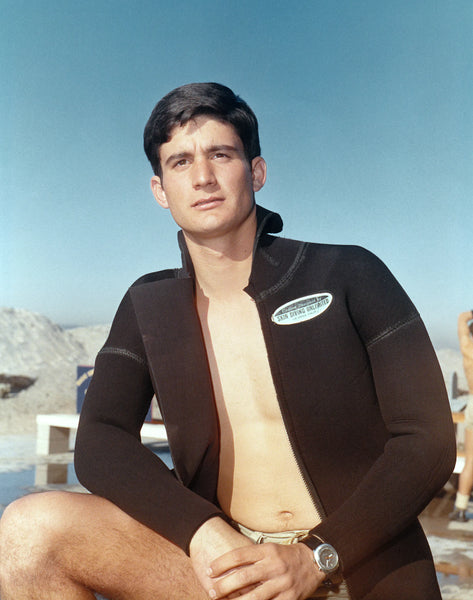
Alan Buehler, a member of UDT 11, assisted with the recovery of Apollo 15 & 17. On his wrist, an OMEGA Geneve Chronostop. (Photo Credit: Alan Buehler)
Getting back to watches, there are documented exceptions including the aforementioned Sea Wolf from Zodiac and the intriguing use of an OMEGA Geneve Chronostop, but in the majority of archival films and photography from these missions, UDT men are seen wearing Tudor Submariners (Reference 7928) the issue watch for Navy divers and SpecOps at the time.
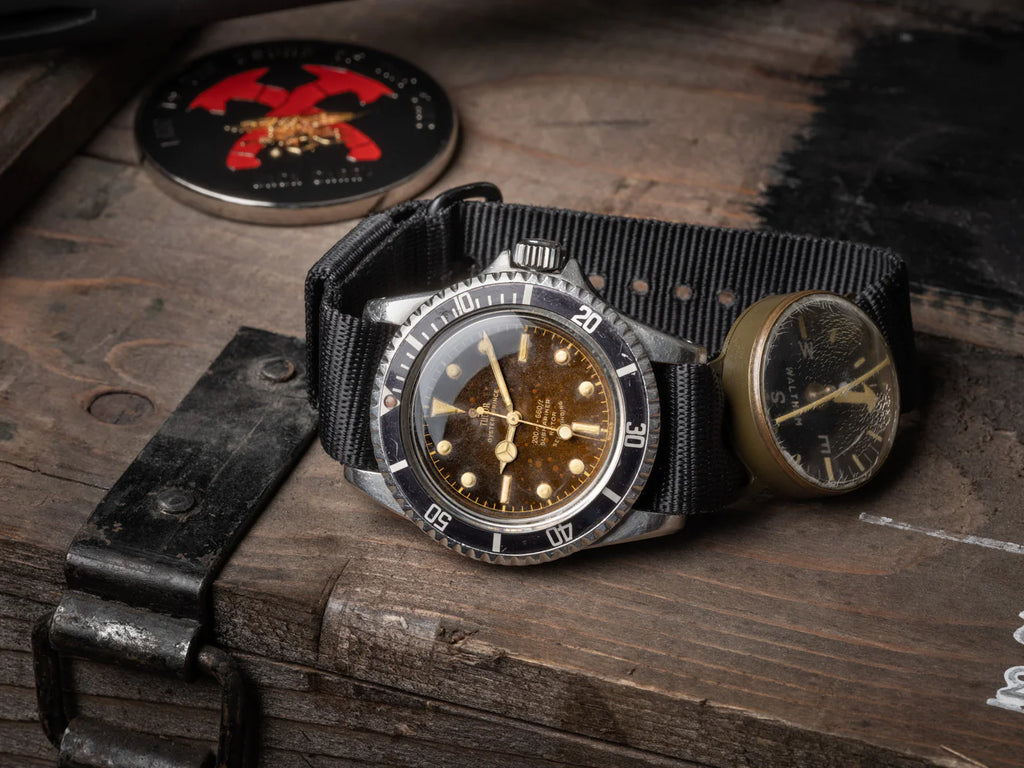
WOE’s personal Tudor Submariner 7928, one of history’s most legendary military dive watches. (Photo Credit: James Rupley)
Eventually earning its own NSN or NATO Stock Number in 1978 (6645-01-068-1088), the Tudor Submariner saw extensive and well-documented service in Vietnam, during astronaut recovery and rescue operations, and even with other specialized units outside of the US Navy. It appears the phenomenon of Tudors of Espionage (T.O.E.) is nothing new.

Bob Coggin of UDT 12 leans against the Apollo 8 Capsule with a Tudor Submariner Ref. 7928 on the wrist. (Photo Credit: NASA)
US Air Force PJs & Astronaut Recovery
NASA augmented its UDT recovery force with US Air Force Pararescuemen or PJs, combat search and rescue specialists who became legendary for their efforts in saving downed pilots in Vietnam. In addition to emergency medicine, technical rescue, parachuting, mountaineering, small unit tactics, and more, PJs were also trained in diving and ocean swimming, making them another excellent option for spacecraft recovery. In essence, the UDT was the recovery team in the event everything went as planned where the PJs served as the global rescue element in case of an emergency that caused a space flight to land somewhere other than on the X.
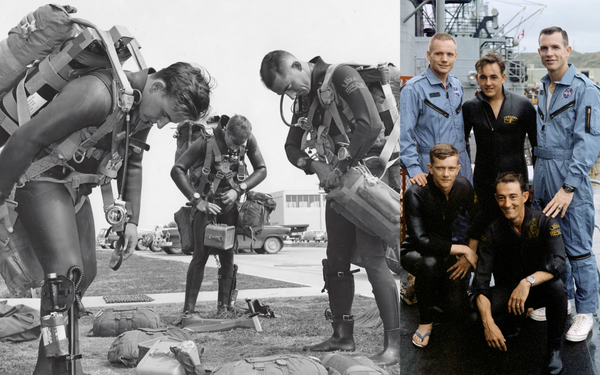
US Air Force Pararescuemen before and after recovering Gemini VIII. In both images, the PJ on the right is wearing a USAF-issued Tudor Submariner 7928. (Photo Credit: NASA)
And that is exactly what happened in 1966 when Gemini VIII entered a potentially deadly spiral in Earth’s orbit. Astronauts David Scott and some guy named Neil Armstrong managed to correct the spin, but the unplanned fuel expenditure meant the mission had to be scrapped. Given the spontaneous nature of the recovery and unplanned splashdown location, the job went to three on-duty US Air Force Pararescuemen out of Okinawa: Larry Huyett, Eldridge Neal, and Glenn Moore. In photos taken both before and after the operation, one of the PJs is seen wearing yet another Tudor Submariner Ref. 7928, a watch that was also commonly issued to PJs during the era.

LTJG David R. Kohler of the Apollo-Soyuz Recovery Team with a Tudor Submariner on the wrist. (Photo Credit: Navy SEAL Museum)
Jumping ahead, UDT Frogmen were in the water for the recovery of the Apollo-Soyuz Test Flight in 1975, the first manned space flight carried out jointly between the United States and the Soviet Union. Soon after, the United States shifted its focus to the Space Shuttle Program. For the first time, a spacecraft could re-enter Earth’s atmosphere, fly to its destination, and land like a traditional aircraft, obviating the need for water landings and recovery teams from the SpecOps community, at least for the next few decades.
Commercial Space Travel
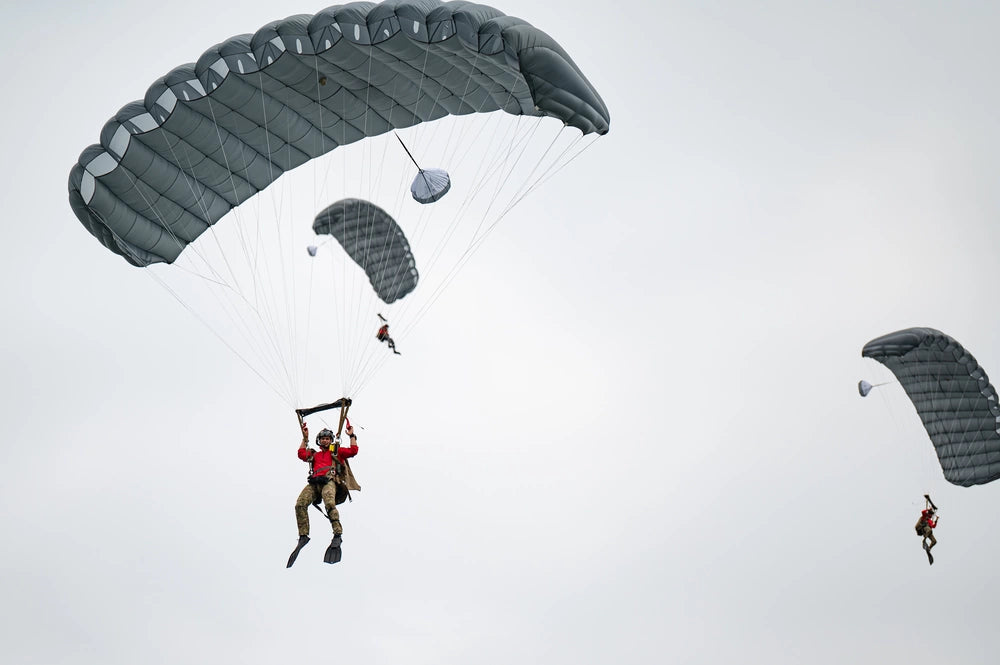
Pararescuemen assigned to the 38th Rescue Squadron conduct water jumps in support of astronaut rescue operations for SpaceX in 2021. (Photo Credit: US Air Force)
The rise of privatized commercial space travel has changed the picture for DOD’s involvement in astronaut recovery and rescue operations. For private space flights, the companies themselves are responsible for their recovery operations. For anything NASA-related and/or taxpayer-funded including the upcoming Artemis missions, the US Navy again serves as the primary recovery force, typically utilizing a blend of Navy Divers, SAR medics, and EOD Technicians. For anything requiring rescue, again more so in the event of an emergency, US Air Force Pararescue Teams also receive specialized training for capsule operations and are strategically located around the globe.
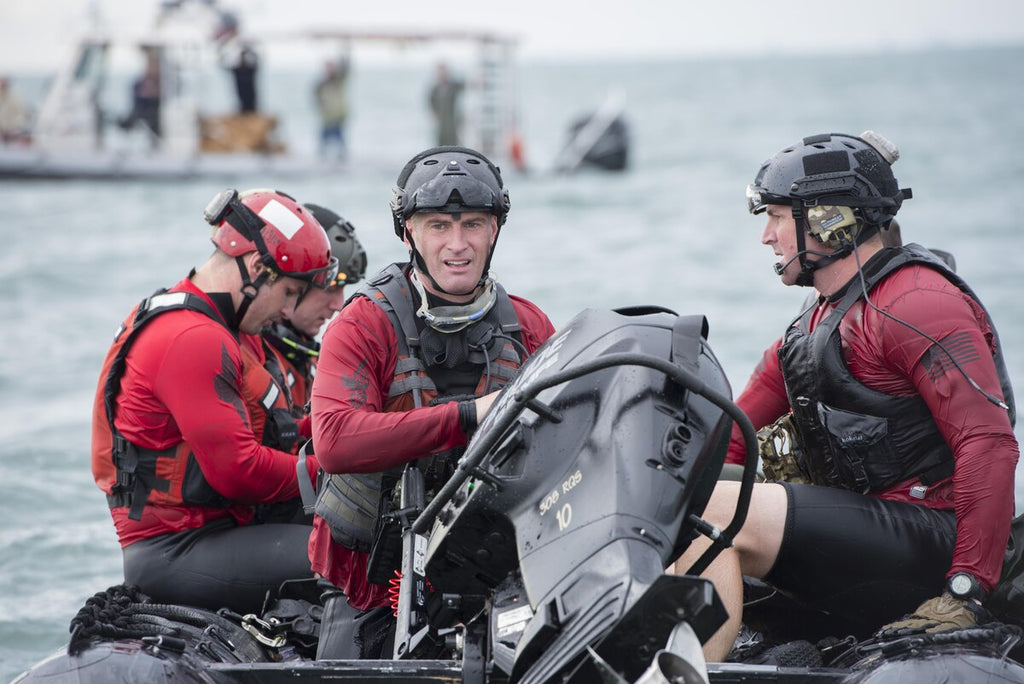
Members of the 308th Rescue Squadron (RQS) “Guardian Angels” train with the Department of Defense's Human Space Flight Support Office, the only full-time organization that coordinates and trains personnel to support human spaceflight contingencies. (Photo Credit: US Air Force)
Just as space flight has advanced technologically in leaps and bounds, watches have also progressed, much to the chagrin of die-hard mechanical timekeeping enthusiasts. Feature-rich digital watches from brands like G-Shock and Garmin now account for the majority of wrists in these specialized military communities. That said, there are plenty of watch enthusiasts in the military, the intelligence community, among astronauts, and even within the Pararescue community associated with SpaceX as we saw with RJ Casey.
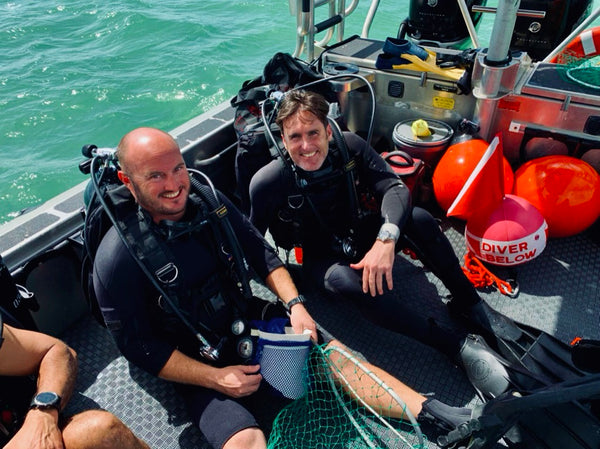
RJ Casey, pictured with his Rolex Submariner, and Louie Haus diving with the 308 RQS. (Photo Credit: PJ Ricky Dunn)
While it’s difficult to compare the Space Program of the 1960s to today, the importance of safeguarding those who have recently returned to Earth remains all but unchanged. Highly skilled amphibious operators still stand at the ready to jump into the sea to assist astronauts in peril. Despite being overshadowed by sexier aspects of space travel that tend to garner the limelight, these complex, multifaceted recovery operations are a key component of what has made and continues to make space exploration possible. When men or women go into the sea to recover astronauts, whether it’s a Tudor Submariner or Zodiac Sea Wolf of old or a modern G-Shock, Garmin, or Bremont, the importance of a precision watch remains a critical instrument for human space flight rescue and recovery teams.
--
If you enjoyed this article, please consider signing up for our weekly free newsletter for further updates HERE.
Read Next: An Exploration of “Unit Watches” from the Special Operations Community: Tudor
To learn more about RJ Casey, check out his Instagram.
About The Author: Benjamin Lowry is a US Coast Guard veteran and commercial diver turned watch writer. Now a full-time member of the W.O.E. Team, Ben splits his time between writing and product development at W.O.E. and managing @SubmersibleWrist, a watch spotting account dedicated to military and commercial divers as well as the life aquatic.

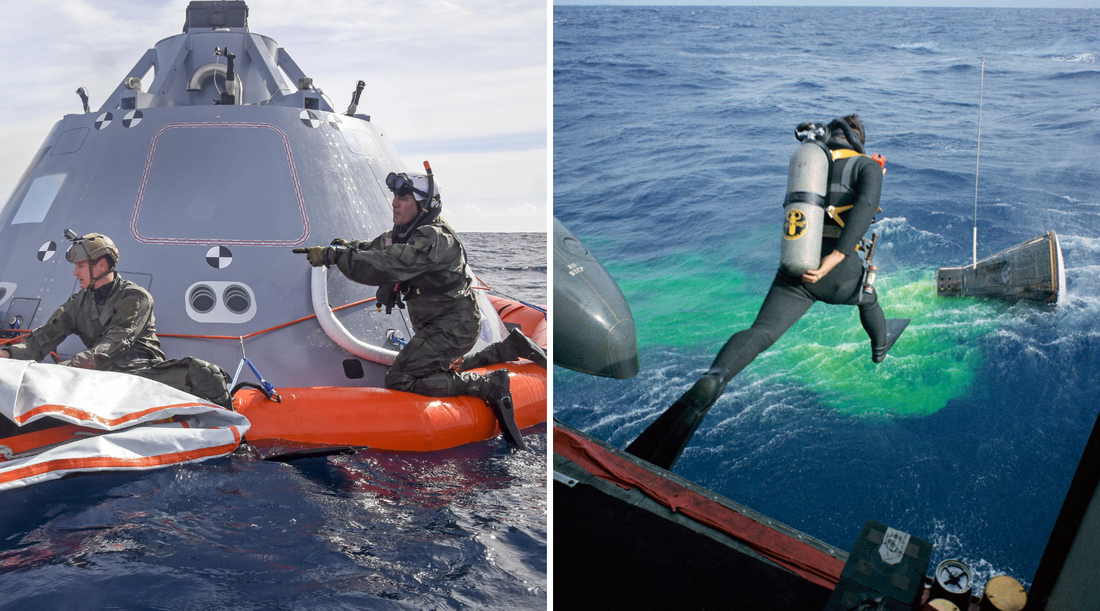
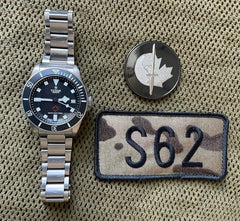





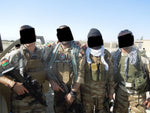
9 comments
Ben Lowry’s move to the WOE staff is tremendous news. His articles are always well written, throughly researched and seriously interesting. Whoever recruited Ben should give themselves a pat on the back. Ben’s experience and his love for watches are a perfect match for WOE.
Fantastic job. Awesome article!!! Congratulations, Ben!!!!
Ben has a keen eye and a talent for writing – couldn’t think of a better addition to WOE.
A fantastic look at the history of space travel and those who risked everything to keep those astronauts safe! Love the linkages with the legendary watches. The man truly does make the watch!
Great article! You can’t go wrong with space travel, special operations, and watches.
Congratulations, Ben!